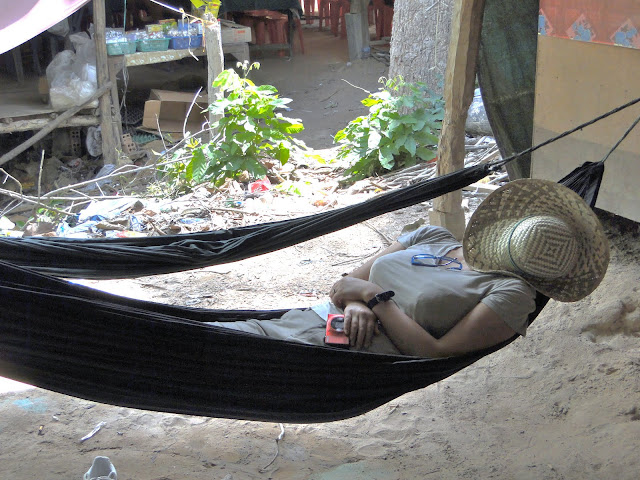Angkor Thom was known as the "Great City", the most enduring capital city of the Khmer Empire. It was established by King Jayavarman ll in the late 12th century. Angkor Thom comprises a group of temples walled and surrounded by moat. Five Gopuras serves as the entrance, North, South, East, West Gates and the Victory Gopura. Temples inside the walls of the city are Bayon, Baphuon, Phimeanakas, Terrace of the Elephants, Terrace of the Leper King, Prah Palilay, Tep Pranam, and Prasat Suor Prat.
Angkor is a Khmer term meaning "city". It comes from the Sanskrit nagara.
Thom is a Khmer term meaning "large". (Angkor Thom means "large city".)
Gopura is a Sanskrit term meaning "entrance pavilion" or "gateway".
Bayon is the Temple of Stone Faces, looking at far they seem like stone mountains. This is another favorite temple by visitors. Anyone will be amazed when they get closer to the Bayon.
Take a look at those magnificent mountain-peaks transformed into beaming stone faces.
As most of the buildings within the Royal Palace complex are for non-religious purposes, they are constructed mainly of wood, which is perishable. The religious structures and ponds are still visible reminders of the grandeur of ancient times.
APSARA: Khmer classical dancers use movements and gestures to tell a story much like a mime. Many people consider their style vague or abstract. Dancers do not speak or sing; they dance with a slight smile and are never supposed to open their mouths (though a few dramas have brief speaking parts).
Terrace of the Elephants is located in the Royal Square of Angkor Thom, built at the end of the 12th century, dedicated to Buddhist and replica to Bayon style of art.
Leper King Terrace
This terrace refers to a statue of the Leper King that is on the platform of the terrace.
Prasat Suor Prat
Prasat Suor Prat is located the beginning of the road leading to the Victory Gate of Angkor Thom.
There are legends behind the Prasat Suor Prat. Ropes anchored each of the twelve towers for the acrobats performing at festivals while the King watched the performances of the dancers from one of the towers. Another is that towers used in settling disputes between men. It was just difficult to put all the twelve temples in one frame.
Tep Pranam
Tep Pranam means "The adoring god". The Buddha seated on a "calling the earth to witness" pose.
Elephant Rides
Baphoun
Baphuon represents a mountain called Mt. Meru also Sumeru "Great Meru" a sacred mountain in Hindu and Buddhist mythology. It is undergoing its restoration.
Phimeanakas, The Gold Tower
Phimeanakas According to legend there was a gold tower (Phimeanakas ) inside the royal palace of Angkor the Great where a serpent-spirit with nine heads lived. The spirit appeared to the Khmer king disguised as a woman and the king had to sleep with her every night in the tower before he joined his wives and concubines in another part of the palace. If the king missed even one night it was believed he would die. In this way, the royal lineage of the Khmer was perpetuated.
The Artist
Thanks to you Mr.Chinese for stepping back right on this moment of our timed picture taking, thumbs-up to you :-D
Thanks to the photographer for this very nice "solo" shot.
Month of May is dry to wet season in Cambodia and obviously it was hot hot hot when I went there this year. Thanks to the tuktuk driver who brought his own cooler box for storing our water. Drink lots and lots of water for keeping hydrated in the summer. Relax to recharge the body after the long dehydrating and tiring walk.
 |
| Doze off in a hammock |
 |
| A magazine while resting |





























